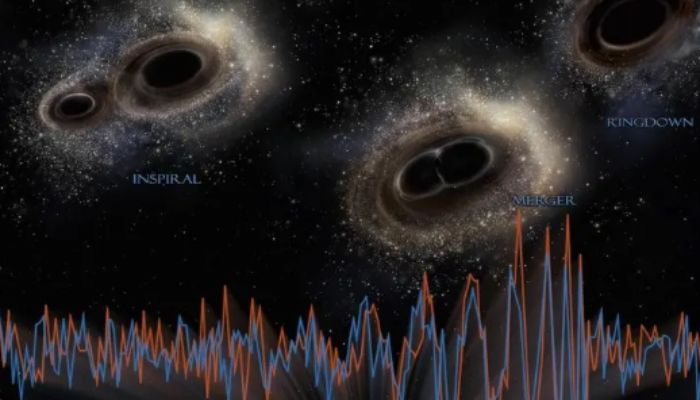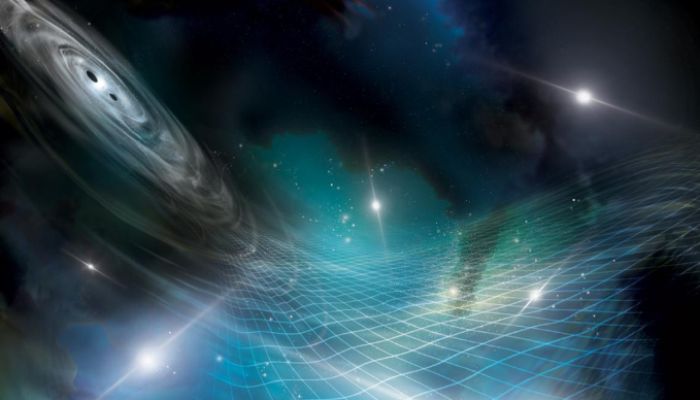Gravitational Waves: Unlocking the Soundtrack of the Universe
- July 1, 2025
- 0
Imagine the universe not as silent and still, but as a vast, ever-changing symphony — with its own soundtrack composed by colliding black holes and dying stars. These
Imagine the universe not as silent and still, but as a vast, ever-changing symphony — with its own soundtrack composed by colliding black holes and dying stars. These

Imagine the universe not as silent and still, but as a vast, ever-changing symphony — with its own soundtrack composed by colliding black holes and dying stars. These cosmic symphonies travel not as sound, but as ripples in the fabric of space and time. Known as gravitational waves, these phenomena were first predicted by Albert Einstein in 1916. A century later, in 2016, scientists finally heard them.
This revolutionary detection marked the birth of a new era in astrophysics. For the first time, scientists weren’t just observing the universe with telescopes — they were listening to it.
Gravitational waves are distortions in the fabric of space-time caused by the acceleration of massive objects. Imagine two black holes orbiting each other and eventually merging — the energy released in that single event is greater than all the light emitted by every star in the universe during that moment. But instead of being emitted as light, the energy travels as waves that stretch and squeeze space-time.

These waves radiate outward from the source, like ripples from a pebble dropped into a pond. Yet by the time they reach Earth, these ripples are incredibly faint — distorting space by less than a thousandth of the width of a proton.
In his general theory of relativity, Einstein predicted the existence of gravitational waves, but even he doubted they could ever be observed. For nearly a hundred years, they remained theoretical — an elegant mathematical possibility with no physical proof.
That changed in September 2015, when the Laser Interferometer Gravitational-Wave Observatory (LIGO) in the United States recorded the telltale chirp of two black holes merging over a billion light-years away. The data was analyzed, scrutinized, and double-checked through a blind validation process. Only after the sealed envelope was opened did the scientists learn: the signal was real.
The discovery was announced in February 2016 and rocked the scientific world.
Detecting gravitational waves isn’t just difficult — it’s like trying to measure the movement of an object by less than a billionth of a millimeter. LIGO’s method was as ingenious as it was extreme: using laser interferometry, a technique that splits a laser beam down two long arms (each 4 kilometers in length), reflects them back, and then recombines them.
If a gravitational wave passed through, it would ever so slightly change the length of one or both arms, altering the interference pattern of the returning light. The changes are minute, but detectable — provided every other vibration, from nearby trucks to earthquakes on the other side of the world, can be filtered out.
To ensure the integrity of detections, a group of scientists secretly injected false signals into the system to test the analysis process. Each time a signal was found, the team had to check whether it was real or a test. In 2015, for the first time, the signal was genuine.

Since that first discovery, observatories like Virgo in Italy and KAGRA in Japan have joined the hunt. Together, they have detected dozens of gravitational wave events, including the merger of neutron stars. One such neutron star collision was seen and heard — producing both gravitational waves and electromagnetic radiation. These events are called “multi-messenger” observations and provide a fuller, richer picture of the cosmos.
For instance, it’s through such events that scientists have gathered evidence for the cosmic origins of heavy elements like gold and platinum — forged in the intense explosions that accompany neutron star mergers.
The detection of gravitational waves has opened an entirely new branch of astronomy. Unlike traditional telescopes that see only light, gravitational wave detectors can “hear” events from parts of the universe that are otherwise invisible — like the interiors of black holes and the earliest moments after the Big Bang.
Future missions like LISA (Laser Interferometer Space Antenna), a space-based gravitational wave detector, aim to take this listening even further — into lower-frequency waves from even more massive and distant events.
The discovery has not gone unrecognized. In 2017, the Nobel Prize in Physics was awarded to Rainer Weiss, Barry Barish, and Kip Thorne for their pioneering work on LIGO. Their efforts have not only confirmed Einstein’s prediction but have also revolutionized how we perceive the universe.
Gravitational waves are more than ripples in space — they are whispers of the universe’s most dramatic stories. As detectors grow more sensitive and collaborations expand globally, the soundtrack of space-time will only grow louder. What was once science fiction is now a profound scientific reality: we are, at last, listening to the heartbeat of the cosmos.